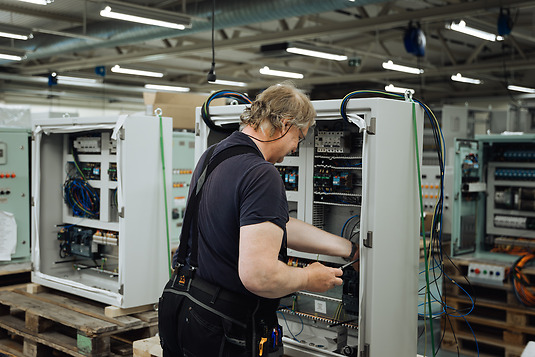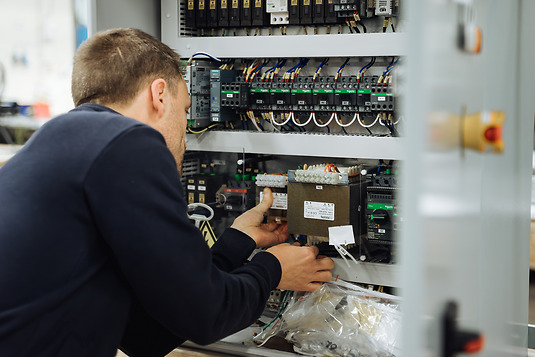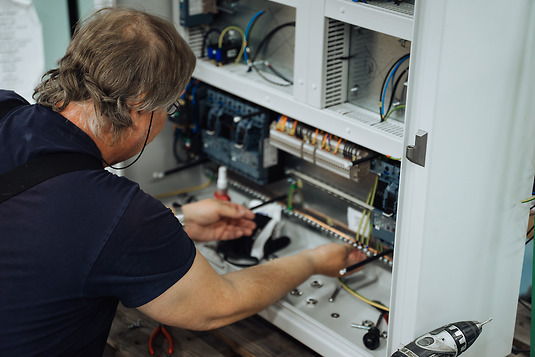
All electrical appliances require some form of control to function as intended. Control and regulation are often associated with machinery or processes, but they can encompass anything from simple switch control to large, complex systems with sensors and detectors. Inside smaller appliances, circuit boards and memory chips are used for control, while larger and more complex systems require additional components. Historically, control cabinets or control panels have been used to address this issue. A control panel generally contains a certain amount of power distribution, while a control cabinet is more focused on control, regulation, and monitoring. The rapid advancements in automation are blurring the distinctions between these types.
Control cabinets are used to manage various aspects of turbine control, protection functions for generators, or process functions for offshore gas installations. This type of process-critical equipment has significant requirements for robustness, reliability, and functionality. Our customers come from commercial, offshore, and military applications, where we can offer control equipment for all these markets.
Control panels are used in industry and buildings to control and regulate lighting, heating, ventilation, process automation, and power circuits. Elektromontage can deliver systems designed and manufactured according to IEC, ATEX, UL/CSA, and even EAC standards. We also design and produce automation equipment for marine applications, which can be classified according to marine classification societies and meet requirements for shock and/or ATEX regulations.
Control panels contain components such as switches, contactors, overcurrent protection, measuring equipment, monitoring units, and communication devices. A control cabinet is often more geared towards a process or machine and therefore contains equipment specifically tailored for this purpose. It may include control systems, vibration monitoring systems, relay protection, and other peripheral devices.
Elektromontage's work often takes place in close collaboration with the customer, with the shared goal of delivering a customized system where functionality, along with personal safety, operational reliability, and energy efficiency, always take precedence. Many of our customers value the assurance of having a supplier that takes responsibility for the entire process, from design to manufacturing complete systems, from control to power distribution on the machine or in the facility.


A control cabinet is a central unit designed to house, protect, and organize electrical components and control systems used to monitor and control various types of electrical facilities. This can include everything from advanced control systems for process industries to solutions for building automation and energy distribution. The cabinet's construction not only ensures protection against external influences such as dust and water but also provides a structured environment for efficient cable management and easy access for service and maintenance. At Elektromontage, we focus on developing customized control cabinets that precisely meet our clients' unique needs, with a high standard of safety, functionality, and adaptability. Our goal is to deliver solutions that are not only technically optimal but also help to simplify operation and maintenance for users.
The needs for industrial automation are multifaceted and include increased efficiency, precision, and productivity. Automation minimizes human error and contributes to consistent and uniform quality of manufactured products. It also enables flexibility in production, where adaptation to new products can occur quickly and efficiently. Additionally, improvements in the work environment are an important aspect, as automation can relieve staff from monotonous and potentially dangerous work. At Elektromontage, we ensure that our clients' automation needs are met by offering innovative solutions that not only optimize production but also support sustainable development and competitiveness in the market.
Industrial automation and control engineering involves the design, implementation, and maintenance of technical systems and software solutions to control production processes and machinery. These systems enable industries to achieve high precision, efficiency, and reliability in their production. By using a broad range of technologies such as PLCs (Programmable Logic Controllers), sensors, and network solutions, automated systems can monitor and adjust production processes in real time. At Elektromontage, we combine our technical expertise with innovative control techniques to develop customized automation solutions that meet our clients' specific needs, helping to optimize their operations and promote growth.
In industrial automation, several key components are necessary to build effective and reliable systems. These include design and configuration software to create and adjust automation processes, integrated architecture to simplify integration and communication between different system parts, and intelligent motor control for efficient machinery management. At Elektromontage, we are dedicated to using and integrating these components to create advanced automation solutions that improve our clients' productivity, safety, and operational efficiency.
An automation system is an integrated network of control units, software, and equipment designed to automate and optimize various processes within an organization. By using technology to replace or assist human efforts in production, management, and monitoring, companies can achieve greater efficiency, precision, and speed in their workflows. These systems can be customized for a range of applications, from manufacturing and inventory management to building automation and more. At Elektromontage, we specialize in developing and implementing customized automation systems that not only improve productivity but also help reduce costs and enhance workplace safety.
A control panel contains a range of components essential for managing and controlling machinery or industrial systems. Key components include switches, indicators, circuit breakers, relays, contactors, Programmable Logic Controllers (PLCs), power supplies, and wiring terminals. Each component plays a specific role, from initiating and stopping processes to protecting against overloads and enabling precise control. Control panels serve as the centralized interface for monitoring and adjusting complex systems, ensuring safe and efficient operation.
A control panel operates by centralizing control and managing the interactions between various devices and machinery within an industrial system. It receives inputs from sensors, operators, or external systems, processes these signals through components like PLCs or relays, and then sends commands to activate or deactivate devices accordingly. The panel provides power as needed to various components, ensures safe operation through circuit breakers and fuses, and enables seamless monitoring and adjustment. This setup allows operators to control and optimize processes from a single interface, improving system efficiency and safety.
A VFD (Variable Frequency Drive) cabinet is an enclosure designed to house a VFD, which controls the speed of electric motors by adjusting the frequency and voltage of the power supplied. VFD cabinets are widely used in industrial facilities to regulate motor speeds for applications such as feed pumps, fans, and conveyor systems, allowing for enhanced efficiency and energy savings. The cabinet protects the VFD from environmental conditions, provides necessary ventilation, and often includes additional controls or protective devices to ensure safe and reliable motor operation.
A transformer control cabinet is a specialized enclosure that houses the components necessary to control, protect, and monitor a transformer’s operation. Inside, standardized equipment such as control relays, protection devices, and measuring instruments are organized on separate levels. One level contains switching devices for power management, while the other level holds control and signaling components, providing operational and maintenance safety. This configuration enables efficient transformer control, ensuring safe and stable power regulation in industrial settings.
The primary objectives of a control panel are to regulate, control, and monitor electrical systems and machinery. Control panels ensure seamless interaction between users and electrical systems, consolidating critical components that help manage and automate processes. By centralizing operations, control panels improve system efficiency, enhance safety, and provide operators with an accessible interface to oversee performance and make adjustments as needed.
UL 508A is the UL (Underwriters Laboratories) standard specifically for the design and construction of industrial control panels in the United States. This standard outlines essential safety requirements, such as proper component selection, wiring methods, and calculation of short-circuit current ratings, ensuring that control panels are built to meet rigorous safety criteria. UL 508A compliance is important for panel builders and users, as it helps ensure the safety, reliability, and code compliance of control panels used in industrial and commercial applications. This standard is often required to expedite approval and installation processes in various jurisdictions across the U.S.
UL requirements for control panels and other UL-listed products include specific warnings, cautions, and labeling to inform users about safe operation, electrical ratings, and installation guidelines. These labels are permanently affixed to UL-certified products to ensure that operators have access to critical safety information. Additionally, UL requirements mandate that control panels meet certain construction standards, including component selection, wiring practices, and short-circuit rating calculations, to ensure safe operation. Compliance with these requirements enhances safety and reliability in various industrial applications, meeting national safety standards and helping avoid operational risks.
The difference between UL 508 and UL 508A lies in their scope and application. UL 508 is the standard for industrial control equipment, covering individual devices such as relays, timers, and other components within control systems. UL 508A, on the other hand, is the standard specifically for industrial control panels and includes guidelines for the safe assembly and construction of these panels, addressing issues like wiring methods and short-circuit ratings. UL 508A compliance applies to the entire control panel, while UL 508 focuses on individual control components. Together, these standards ensure both component and panel safety in industrial applications.
A UL 508A control panel is an industrial control panel that meets the UL 508A safety standard, which provides guidelines for safe design and construction. UL 508A ensures that control panels are built with appropriate component selection, wiring practices, and short-circuit rating calculations, all essential for safe and reliable operation in industrial environments. This certification helps panel builders meet national safety codes and facilitates easier approval for installation in jurisdictions that require UL compliance. UL 508A-certified panels are recognized for meeting stringent safety and quality standards, making them suitable for diverse industrial applications.
The main difference between ATEX and IECEx lies in their geographic scope. ATEX certification is a European Union directive that applies to equipment intended for use in explosive atmospheres within EU countries. IECEx, on the other hand, is an international certification system for equipment in hazardous locations, accepted in multiple countries worldwide. While both standards aim to ensure safety in explosive atmospheres, IECEx is generally more versatile for manufacturers seeking to sell their equipment globally. For equipment intended for EU markets, ATEX compliance is mandatory, while IECEx offers broader, international acceptance across participating countries.
ATEX environments are areas where flammable gases, vapors, mists, or combustible dusts may be present, creating a risk of explosion. Examples of ATEX environments include oil and gas facilities, where flammable gases are prevalent; grain storage or processing facilities, where dust from cereals, flour, or sugar can ignite; mining operations with coal dust; and chemical plants handling volatile compounds. ATEX certification is required for equipment used in these settings to ensure safe operation and protect workers from potential explosions. Each environment has specific ATEX zone classifications based on the frequency and duration of explosive atmospheres.
ATEX zones are divided into three gas zones and three dust zones to classify the likelihood and duration of explosive atmospheres: Gas Zones: - Zone 0: Constant presence of explosive gas. - Zone 1: Occasional presence of explosive gas during normal operation. - Zone 2: Explosive gas present only under abnormal conditions. Dust Zones: - Zone 20: Constant presence of combustible dust. - Zone 21: Occasional presence of combustible dust during normal operation. - Zone 22: Combustible dust present only under abnormal conditions. These zones help determine the required safety standards and equipment specifications to prevent ignition sources in hazardous environments.
An ATEX enclosure is a specially designed protective box that houses electrical or electronic components in hazardous areas where explosive atmospheres may exist. These enclosures comply with the ATEX directive, ensuring that they minimize ignition risks from electrical equipment. ATEX enclosures are built to contain or prevent sparks, heat, or other ignition sources that could trigger an explosion. They are commonly used in industries like oil and gas, chemical processing, and mining, where ATEX-certified equipment is required for safety and regulatory compliance in explosive atmospheres.